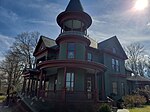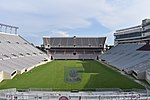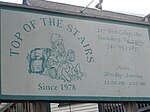Miller–Southside Residential Historic District
Blacksburg, VirginiaColonial Revival architecture in VirginiaHistoric districts in Montgomery County, VirginiaHistoric districts on the National Register of Historic Places in VirginiaMontgomery County, Virginia Registered Historic Place stubs ... and 3 more
NRHP infobox with nocatNational Register of Historic Places in Montgomery County, VirginiaUse mdy dates from August 2023
Miller–Southside Residential Historic District is a national historic district located at Blacksburg, Montgomery County, Virginia. The district encompasses 165 contributing buildings in a predominantly residential section of the town of Blacksburg. The residences date between 1909 and 1941, and are in a variety of popular architectural styles including American Foursquare, Bungalow, and Colonial Revival.It was listed on the National Register of Historic Places in 1991.
Excerpt from the Wikipedia article Miller–Southside Residential Historic District (License: CC BY-SA 3.0, Authors).Miller–Southside Residential Historic District
Draper Road, Blacksburg
Geographical coordinates (GPS) Address Nearby Places Show on map
Geographical coordinates (GPS)
| Latitude | Longitude |
|---|---|
| N 37.221666666667 ° | E -80.407222222222 ° |
Address
Draper Road 907
24063 Blacksburg
Virginia, United States
Open on Google Maps









